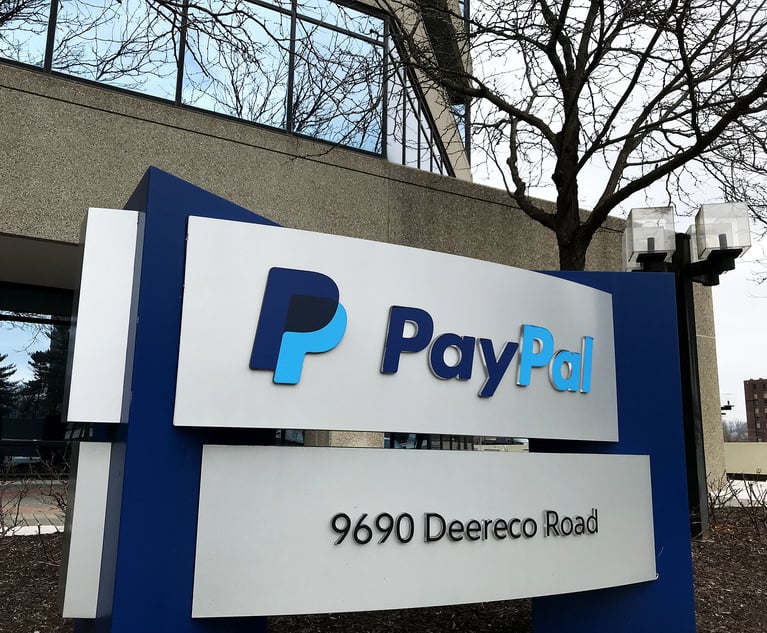Inside Law Firms' Best Results in a Decade
Law firms were able to grow revenue more than expenses despite a big rise in the cost of associate salaries.
February 10, 2019 at 06:00 PM
11 minute read
The original version of this story was published on The American Lawyer

The law firm industry last year posted its best results in more than 10 years.
Post-recession highs in demand and billing rate growth drove strong revenue growth—critical in a year where expense growth accelerated. As a result, the industry saw the strongest net income and profits per equity partner growth we've seen since 2007.
Am Law 50 firms and niche/boutique firms outperformed the rest of the industry on average, and the Am Law Second 50 were not far behind. And while dispersion remained, the good news is that we saw a larger proportion of firms enjoy demand growth. Even among the Am Law Second Hundred firms, whose performance as a group lagged the other segments, an increased proportion of firms saw demand improvement. With strong inventory growth at year-end, the industry is well-positioned for a strong start to 2019.
These results are based on a sample of 191 firms (75 Am Law 100 firms, 54 Second Hundred firms and 62 niche/boutique firms). Thirty-seven of these firms fit our definition of either “international” (between 10 and 25 percent of lawyers based outside the United States), or “global” (at least 25 percent of lawyers based outside the United States). Firms with less than 10 percent of lawyers based outside the United States are classified as either “national” (less than 50 percent of total lawyers based in headquarter office) or “regional” (more than 50 percent of lawyers based in headquarter office). Citi Private Bank provides financial services to more than 600 U.S. and U.K. law firms and more than 35,000 individual lawyers. Each quarter, the Law Firm Group confidentially surveys firms in the Am Law 100 and the Second Hundred, along with smaller firms. In addition, we conduct a more detailed annual survey and produce the Law Firm Leaders Confidence Index semiannually. These reports, together with extensive discussions with law firm leaders, provide a comprehensive overview of financial trends in the industry as well as forward-looking insight.
Revenue growth of 6.4 percent was greater than the 4.5 percent growth seen the previous year. Underlying demand growth picked up in the fourth quarter of 2017 and carried that momentum into 2018, building each quarter through the first nine months. In the fourth quarter, demand growth slowed somewhat, due in part to the high bar set by 2017's strong fourth quarter, but we also heard anecdotally that market choppiness affected demand levels. Even so, 2018 demand finished up 2.3 percent, compared to 0.7 percent in 2017. The only year in recent memory that came close was 2014, when the industry benefited from a rebound in mergers and acquisitions and reported 1.9 percent growth.
Lawyer billing rate growth was also strong, up 4.3 percent, compared to 3.7 percent in 2017, and the strongest increase we've seen since 2008. Even with this strong increase, we only observed a marginal decline in accrual realization, suggesting that the market tolerated this greater than usual rate increase.
The only notable drag on revenue growth was a 0.6 percent lengthening of the collection cycle, following a 1.5 percent slowdown the previous year. We've heard from some law firms that clients have been increasingly slowing their payments.
Lawyer head count grew 1.4 percent, on top of 2017's 1.9 percent. Equity partner head count, however, continued to drop—down 0.6 percent compared to 0.3 percent the previous year. This continued the trends over the past decade of actively managing equity partner head count, as well as the steady increase in leverage.
Further testament to the strong overall performance for the law firm industry last year was that while firms increased head count, they also saw lawyer productivity improve 1 percent—the first improvement since 2014.
Looking at expenses, the pace of growth increased for the second consecutive year, up 6.1 percent, compared to 4.5 percent in 2017 and 3.4 percent in 2016. Not surprising, 2018's expense growth was driven primarily by an increase in lawyer compensation expenses—7.7 percent compared to 6.5 percent the previous year—reflecting not only the increase in salaried lawyer head count, but also the impact of the second mid-year associate salary increase in the past three years. Overhead expenses also picked up quite a bit—4.9 percent compared to 3.1 percent the previous year—driven by technology, real estate and other infrastructure investments. It's worth noting that last year's lawyer compensation and overhead expense increases were both the highest in at least 10 years.
Despite increasing by the highest percentage in a decade, expense growth was still less than revenue growth, so profit margins improved. By comparison, in 2017 revenue and expense growth were the same. As a result, 2018 net income improved by 6.9 percent and, with the modest decline in equity partner head count, profits per equity partner were up 7.5 percent.
On the strength of the increases in demand and billing rates, as well as the slowdown in collections, year-end inventory was up 7.1 percent, higher even than the strong 6.1 percent increase reported at the end of 2017. Last year's increase was well-balanced between increases in both accounts receivable (7.6 percent) and unbilled time (6.5 percent), which suggests that collections should be fairly strong well into the first quarter and perhaps beyond.
Behind the industry averages, while we continued to see performance dispersion, a greater proportion of the industry enjoyed growth—61 percent of firms enjoyed an increase in demand, and 74 percent an increase in PPEP (versus 56 percent and 68 percent, respectively, in 2017). In addition, volatility in performance from one year to the next actually decreased. Measured by alternating years of growth and decline and based on a common sample of 146 firms that reported to us in 2017 and 2018, we noted that 37 percent of firms experienced reverse trends in demand performance, down from 45 percent in the prior two-year period. Furthermore, 41 percent of firms enjoyed two consecutive years of demand improvement, compared with only 31 percent during the prior two-year period. The same was true for PPEP—only 44 percent of firms experienced volatility, compared with 51 percent during the prior two-year period, and slightly over half (51 percent) of firms enjoyed two consecutive years of increase, compared with only 42 percent in the prior two-year period. This increased percentage of firms enjoying improvement, coupled with a reduction in volatility, should help reduce some of the anxiety that can come with swings in performance.
Looking at the results by revenue size, for the third year in a row, Am Law 50 firms saw greater revenue growth (7.7 percent) than the other segments, driven by the strongest increases in both demand (2.9 percent) and lawyer billing rates (4.6 percent). Despite expense growth of 7.6 percent that almost matched revenue growth, this segment recorded impressive profitability gains—7.8 percent in net income, and 8.4 percent in PPEP. They are also well-positioned ahead of the other segments heading into 2019 with by far the strongest inventory growth (8.7 percent).
Within the Am Law 200, while the spotlight continued to shine most brightly on Am Law 50 firms, Am Law Second 50 firms also had a very solid year. Demand grew 2.2 percent and lawyer billing rates were up 3.7 percent, driving revenue growth of 4.8 percent, while net income and PPEP grew 6.8 percent and 5.7 percent, respectively. The only notable drag on performance was a slowdown in the collection cycle. On the bright side, this slowdown contributed to a 6.1 percent growth in inventory, suggesting that Am Law Second 50 firms should also have a strong start to 2019 collections.
The experience continued to be very different for Am Law Second Hundred firms, with revenue growth of only 2.2 percent. After managing profit margin improvement in 2017, this was the only segment to see revenue growth lag expense growth (2.9 percent) last year. Although the Second Hundred firms managed a modest 0.3 percent improvement in demand after enduring a 0.9 percent decline the previous year, lawyer billing rate increases of 2.8 percent lagged all other segments. Net income and PPEP growth of 1 and 3.3 percent, respectively, were also well behind all the other segments. It should be noted, however, that true to the pattern of dispersion we've witnessed in the industry, not all of the Am Law Second Hundred firms struggled, with 43 percent reporting growth in demand last year, compared to 40 percent the previous year.
Outside of the Am Law 200, the niche/boutique firms recorded strong increases in both net income and PPEP (8.9 percent and 8.7 percent, respectively). These firms saw revenue growth of 6.8 percent, second only to the Am Law 50, on the strength of balanced growth in demand (2.2 percent) and billing rates (3.2 percent), and further benefited from a 1.6 percent improvement in the collection cycle. As is becoming increasingly evident, revenue performance isn't necessarily a matter of size—it's also about brand and perceived value.
Although these firms came relatively close to matching the largest firms in terms of lawyer compensation expense growth (8.2 vs. 9.4 percent), due in large part to having the greatest increase in lawyer FTE (2.2 percent) of all the segments, the big difference was that these smaller firms only increased overhead by 3.3 percent, compared with 6.2 percent for the largest firms. With 5 percent growth in inventory, these firms should expect a good start to 2019 collections.
When we examine the results by geographic reach, global and international firms outperformed national and regional firms in revenue growth on the strength of comparatively stronger underlying demand and lawyer billing rate growth. But they also had greater expense growth—in both lawyer compensation and overhead expenses. Despite the expense growth, global firms saw the greatest net income growth of all the segments (7.6 percent), and international firms the greatest PPEP growth (8.2 percent), following a reduction in equity partner head count. Both also had greater growth in inventory than the other two segments, paving the way for strong first-quarter 2019 collections. Although national and regional firms lagged in terms of revenue growth, they were the only two segments to see improvement in their profit margins. By reducing equity partner head count, they also enjoyed very solid increases in PPEP of 7.8 and 6.8 percent, respectively.
The law firm industry has begun 2019 with strong inventory growth, rate increases and activity levels. With expense pressure likely to accelerate, strong top-line growth will be an imperative. As we wrote in the 2019 Citi Hildebrandt Client Advisory, we project another strong year in top-line growth for the industry, in the range of 6 to 7 percent, with dispersion continuing across and within market segments, and likely leading to further consolidation. While we don't anticipate a downturn in 2019, Citi's view is that this is likely to occur in 2020. With the investments firms have been making in both overhead and lawyer head count, it's reasonable to wonder whether firms are headed toward some uncomfortable belt-tightening in 2020, if not later this year. Perhaps the biggest expense management opportunity for firms is to look at the composition of their leverage models and determine whether they are profitable at every level. Looking at 2019 and beyond, the market will favor firms that have the strongest brands, deepest client relationships and the most efficient service delivery and leverage models.
John Wilmouth is a senior client advisor in Citi Private Bank's Law Firm Group, and Gretta Rusanow is head of advisory services. Citi Private Bank is a business of Citigroup Inc., which provides its clients access to products and services through bank and nonbank affiliates of Citigroup. Not all products and services are provided by all affiliates or are available at all locations. The views expressed herein are for informational purposes only and are those of the authors and do not necessarily reflect the views of Citigroup Inc. All opinions are subject to change without notice
This content has been archived. It is available through our partners, LexisNexis® and Bloomberg Law.
To view this content, please continue to their sites.
Not a Lexis Subscriber?
Subscribe Now
Not a Bloomberg Law Subscriber?
Subscribe Now
NOT FOR REPRINT
© 2025 ALM Global, LLC, All Rights Reserved. Request academic re-use from www.copyright.com. All other uses, submit a request to [email protected]. For more information visit Asset & Logo Licensing.
You Might Like
View All
NY AG James Targets Crypto Fraud Which Allegedly Ensnared Victims With Fake Jobs
4 minute read
CFPB Alleges Berkshire Hathaway Subsidiary Originated Unaffordable Housing Loans

Class Certification, Cash-Sweep Cases Among Securities Litigation Trends to Watch in 2025
6 minute read
'Biggest Influencer Scam of All Time'?: PayPal Accused of Poaching Commissions Via Its 'Honey' Browser Extension
Trending Stories
- 1Arbitrators Under Fire for Allegedly Forcing Workers to 'Stay or Pay' Employers
- 2Plaintiff Narrowly Avoids Dismissal Over Lengthy Complaint Filed in Federal Court
- 3Goodwin to Launch Brussels Office With Quinn Emanuel Antitrust Partner
- 4Looking to the Future of the FDA and Its Impact on Drug Regulation in 2025
- 5Pennsylvania Firms Join Partnership Promotion Parade
Who Got The Work
Michael G. Bongiorno, Andrew Scott Dulberg and Elizabeth E. Driscoll from Wilmer Cutler Pickering Hale and Dorr have stepped in to represent Symbotic Inc., an A.I.-enabled technology platform that focuses on increasing supply chain efficiency, and other defendants in a pending shareholder derivative lawsuit. The case, filed Oct. 2 in Massachusetts District Court by the Brown Law Firm on behalf of Stephen Austen, accuses certain officers and directors of misleading investors in regard to Symbotic's potential for margin growth by failing to disclose that the company was not equipped to timely deploy its systems or manage expenses through project delays. The case, assigned to U.S. District Judge Nathaniel M. Gorton, is 1:24-cv-12522, Austen v. Cohen et al.
Who Got The Work
Edmund Polubinski and Marie Killmond of Davis Polk & Wardwell have entered appearances for data platform software development company MongoDB and other defendants in a pending shareholder derivative lawsuit. The action, filed Oct. 7 in New York Southern District Court by the Brown Law Firm, accuses the company's directors and/or officers of falsely expressing confidence in the company’s restructuring of its sales incentive plan and downplaying the severity of decreases in its upfront commitments. The case is 1:24-cv-07594, Roy v. Ittycheria et al.
Who Got The Work
Amy O. Bruchs and Kurt F. Ellison of Michael Best & Friedrich have entered appearances for Epic Systems Corp. in a pending employment discrimination lawsuit. The suit was filed Sept. 7 in Wisconsin Western District Court by Levine Eisberner LLC and Siri & Glimstad on behalf of a project manager who claims that he was wrongfully terminated after applying for a religious exemption to the defendant's COVID-19 vaccine mandate. The case, assigned to U.S. Magistrate Judge Anita Marie Boor, is 3:24-cv-00630, Secker, Nathan v. Epic Systems Corporation.
Who Got The Work
David X. Sullivan, Thomas J. Finn and Gregory A. Hall from McCarter & English have entered appearances for Sunrun Installation Services in a pending civil rights lawsuit. The complaint was filed Sept. 4 in Connecticut District Court by attorney Robert M. Berke on behalf of former employee George Edward Steins, who was arrested and charged with employing an unregistered home improvement salesperson. The complaint alleges that had Sunrun informed the Connecticut Department of Consumer Protection that the plaintiff's employment had ended in 2017 and that he no longer held Sunrun's home improvement contractor license, he would not have been hit with charges, which were dismissed in May 2024. The case, assigned to U.S. District Judge Jeffrey A. Meyer, is 3:24-cv-01423, Steins v. Sunrun, Inc. et al.
Who Got The Work
Greenberg Traurig shareholder Joshua L. Raskin has entered an appearance for boohoo.com UK Ltd. in a pending patent infringement lawsuit. The suit, filed Sept. 3 in Texas Eastern District Court by Rozier Hardt McDonough on behalf of Alto Dynamics, asserts five patents related to an online shopping platform. The case, assigned to U.S. District Judge Rodney Gilstrap, is 2:24-cv-00719, Alto Dynamics, LLC v. boohoo.com UK Limited.
Featured Firms
Law Offices of Gary Martin Hays & Associates, P.C.
(470) 294-1674
Law Offices of Mark E. Salomone
(857) 444-6468
Smith & Hassler
(713) 739-1250








